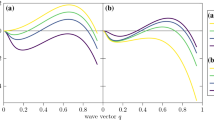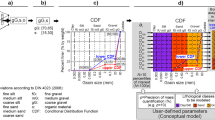Abstract
The evolution of early diagenetic calcite cements in microbial mats of recent supratidal sediments of the southern North Sea is modeled in a two-dimensional microscale approach by a cellular automaton model (CAM). Calcite is traced out in the model by virtual calcium distribution patterns obtained from runs under different assumptions concerning sediment-intrinsic conditions. For justification of the CAM, real calcium distribution patterns, documented by scanning electron microscopy coupled with energy-dispersive X-ray spectrometry (SEM/EDX), are quantitatively compared with the virtual patterns on the basis of multifractal analyses. The formation of high magnesian calcite as a consequence of biogenic anaerobic decomposition of organic matter starts at certain initial calcite domains. In this stage an inhomogeneous and multifractal calcium distribution is characteristic. Nearly complete remineralization of organic matter leads to monofractal behavior of generalized fractal dimensions (DB(q) ±1.84). The CAM results confirm that calcite formation is a self-determining morphogenetical process and diffusive transport processes of reactants within the mat affect the biogenic calcite formation.
Similar content being viewed by others
References
Avnir D, Farm D (1989) The fractal nature of molecule-surface interactions on reactions. In: Avnir D (ed) The fractal approach to heterogeneous chemistry. Wiley, Chichester
Berner RA (1971) Principles of chemical sedimentology. McGraw-Hill, New York, pp 1–240
Bölviken B, Stokke PR, Feder J, Jössang T (1992) The fractal nature of geochemical landscapes. J Geochem Explor 43:91–109
Block A, Blob W von, Schellnhuber HJ (1990) Efficient box-counting determination of generalized fractal dimensions. Phys Rev A 42:1869–1874
Block A, Blob W von, Klenke T, Schellnhuber HJ (1991) Multifractal analysis of the microdistribution of elements in sedimentary structures using images from scanning electron microscopy and energy dispersive X-ray spectrometry. J Geophys Res 96:16223–16230
Havlin S (1989) Molecular diffusion and reactions. In: Avnir D (ed) The fractal approach to heterogeneous chemistry. Wiley, Chichester
Halsey TC, Jensen MH (1986) Spectra of scaling indices for fractal measures: theory and experiment. Physica D 23:112–117
Hayakawa H, Sato S, Matsushita M (1987) Scaling structure of the growth-probability distribution in diffusion-limited aggregation processes. Phys Rev A 36:1963–1966
Hentschel HGE, Procaccia I (1983) The infinite number of fractal dimensions of fractals and strange attractors. Physica D 8:4435–4444
Feder J (1992) Fractals. Plenum Press, New York, pp 1–283
Gerdes G, Krumbein WE, Reineck HE (1985) The depositional record of sandy versicolored tidal flats (Mellum Island, southern North Sea). J Sediment Petrol 55:265–278
Klenke T, Block A, Blob W von, Kappertz P, Schellnhuber HJ (1992) Fraktale Strukturen: Dokumente genetischer Prozesse and intrinsischer Eigenschaften von Sedimenten. Zentralbl. Geol Paläontol II 12: 2785–2795
Korvin G (1992) Fractal models in the earth science. Elsevier, Amsterdam, pp 1–396
Krohn CE (1988a) Sandstone fractal and Euclidean pore volume distributions. J Geophys Res 93:3286–3296
Krohn CE (1988b) Fractal measurements of sandstones, shales and carbonates. J Geophys Res 93:3297–3305
Kropp J, Block A, Bloh W von, Klenke T, Schellnhuber HJ (1994) Characteristic multifractal element distributions in recent bioactive marine sediments. In: Kruhl JH (ed) Fractals and dynamic systems in geosciences. pp 369–375
Riege H, Villbrandt M (1994) Microbially meditated processes in tide influenced deposits and their importance in stabilization and diagenesis of sediments: seasonal field studies, Norderney survey. In: Krumbein WE, Stal LJ, Paterson DM (eds) Biostabilization of sediments. pp 339–360
Tél T (1988) Fractals, multifractals and thermodynamics. An introductory review. Z Naturforsch 43a: 1154–1174
Toffoli T, Margolus N (1987) Cellular automata machines: a new environment for modeling. MIT Press, Cambridge, pp 1–259
Wolfram S (1983) Statistical mechanics of cellular automata. Rev Mod Phys 55:601–644
Author information
Authors and Affiliations
Rights and permissions
About this article
Cite this article
Kropp, J., von Blob, W. & Klenke, T. Calcite formation in microbial mats: modeling and quantification of inhomogeneous distribution patterns by a cellular automaton model and multifractal measures. Geol Rundsch 85, 857–863 (1996). https://doi.org/10.1007/BF02440116
Received:
Accepted:
Issue Date:
DOI: https://doi.org/10.1007/BF02440116




